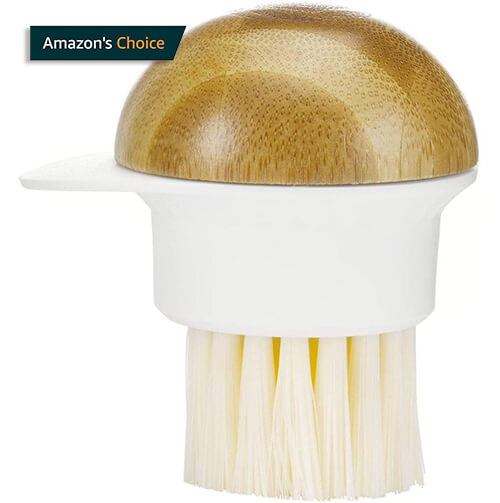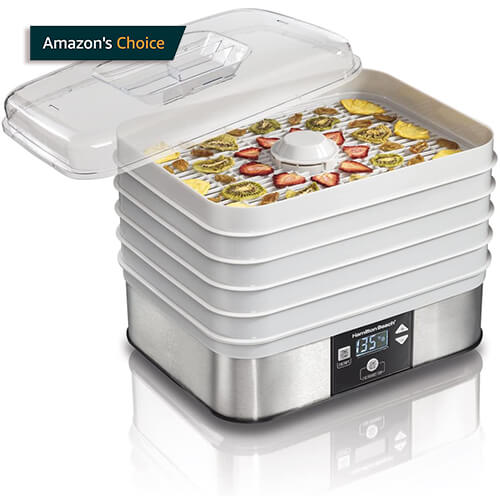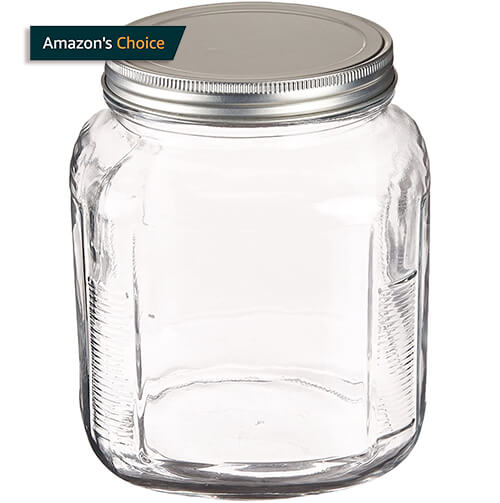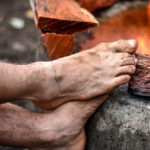Learning the ways to store wild fresh mushrooms is an excellent skill that will save you time on planning trips to the parklands and the supermarket. What’s best is that it also limits over stockpiling and wastage.
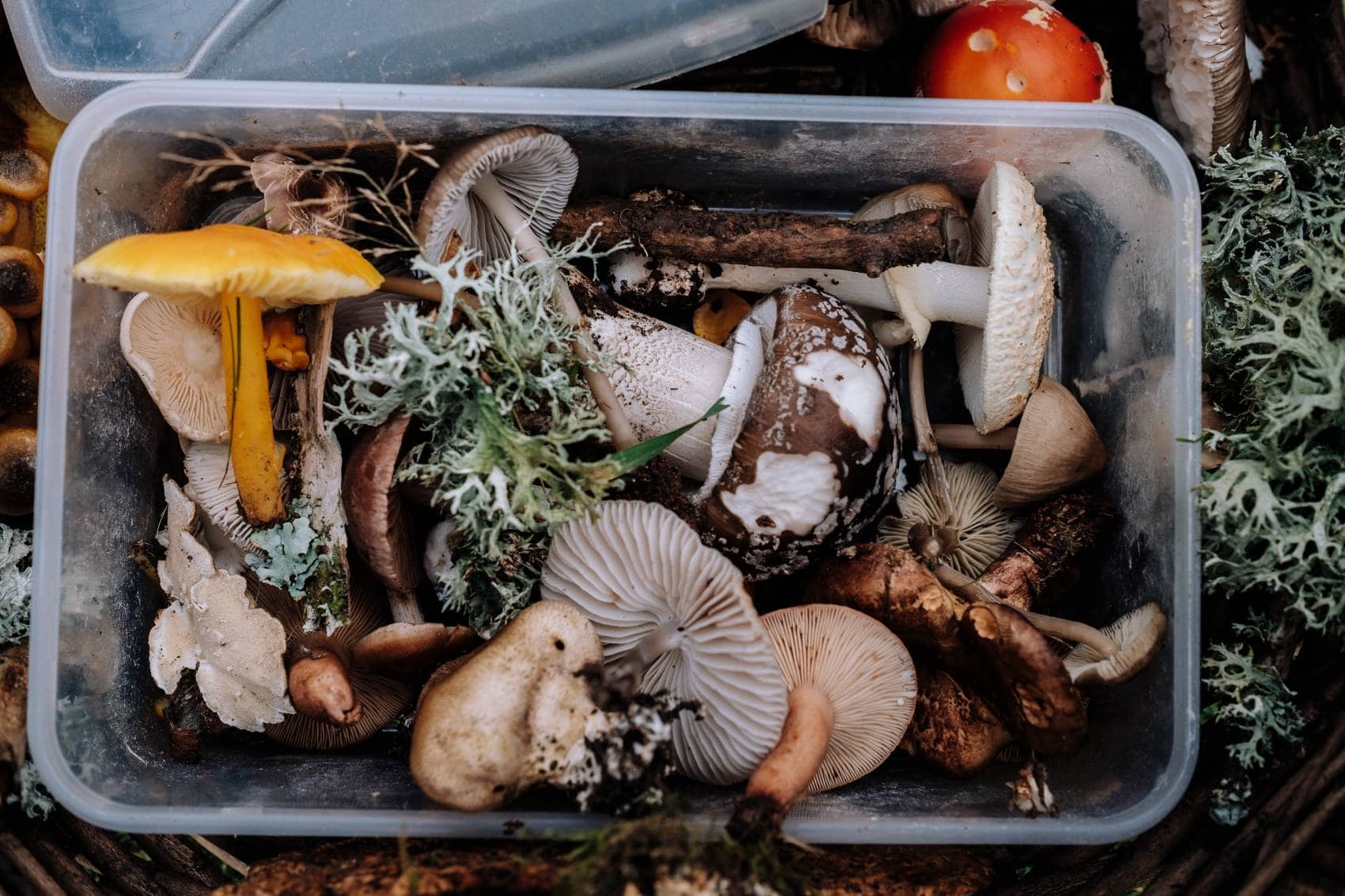
Also, being able to dip into your reserve of stored mushrooms instead of buying retail can save you some money as well.
Before storing wild mushrooms, I would always fall into the trap of over or under picking the number of fresh mushrooms taken from the nature reserve.
Also, I would justify the plain paper bag that supermarkets use to store mushrooms as sufficient enough as a storage method. Boy was I wrong.
This carelessness was often due to the inconvenience of possibly having to plan another trip. I would end up overstocking or asking friends to come to harvest with me.
Other times it was due to the weather forecast being too hot or too cold to promote mushroom growth. Wild mushrooms tend to expire after three days. I felt that I was constantly in a rush to eat or use them before they turned foul.
This led me to research the best ways on storing fresh mushrooms at home; from the cheap and convenient methods to the risky and avoided.
Storing wild mushooms, how is their shelf-life?
Mushrooms prosper in damp, shaded environments. The wetter their habitat, the faster they will grow. It’s common that wild mushrooms can achieve maturity from inception in as little as 24 hours.
Many mushrooms will slime and rapidly degrade once taken out of an ideal environment. Supermarket mushrooms, for example, will sweat and sustain freshness for about three days.
This is mostly due to the oxygen-restrictive plastics that cover the fungi when you purchase them. Sweating mushrooms will slime, promoting bacteria growth which isnt good flavor for cooking.
Contrastingly, fresh mushrooms that are stored in a paper bag will tend to shrivel and dry out. Whilst not as unappealing as slimy mushrooms, the dryer fungi will still change in the flavors and composition.
The benefits of proper storage.
Wild and commercial mushrooms are great as survival food. They can be a great source of Vitamin A through to K, Antioxidants, Fiber, Zinc and Potassium. Storing mushrooms correctly will ensure that you keep these benefits and flavours.
But, freezing mushrooms or drying your cultivated mushrooms will most likely come down to convenience. One requires mostly air, while another method requires a freezer.
Wild mushrooms that have been stored will also need a particular recovery process to bring the fresh mushrooms back to their original prior to use. You should try and premeditate on how you plan to use the mushrooms when storing. Will it be used in a pizza?
Drying may enhance and be an effective method for storage. Will the mushrooms be used in a fresh salad or wrap? Perhaps Canning is and an option to store the mushrooms closer to their original form.
Selection and cleaning shrooms.
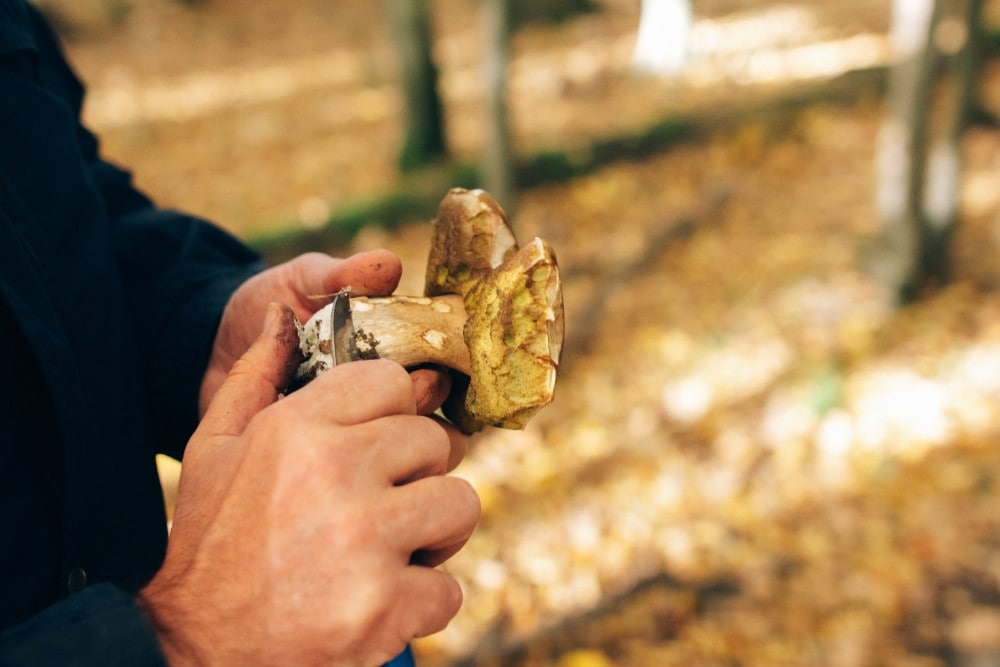
You want to make sure that your wild fresh mushrooms are cleaned thoroughly before storage. Wild mushrooms are riskier because of their exposure to the elements, toxins, and animals. Once harvested run your batch of mushrooms under salted water and soak them overnight.
Pay attention to the underbelly or the gills of the fungus when cleaning, especially if there have been recent heavy rains.
Even if you store fresh mushrooms bought from the supermarket will need washing before storing them. Although they undergo a stringent cleaning process, they will often host dirt that has gotten past the procedure.
Once washed, pat-down and dry the fungi with paper bags or paper towels or leave them to dry at room temperature. If the mushrooms are dry after harvest, you can use a soft bristle brush to remove chunks of dirt before washing.
Another thing you may want to do is to cut off the fibrous stem root where dirt can reside, don’t worry your only removing half a centimeter of the stem at most.
Extra steps I take if I’m really pedantic is to peel the outer veil skin to remove dirt and imperfections further.
Common storage methods.
Freezing fungi method.
Any storage or preservation method (except for Canning) is going to alter the size and shape of your wild mushrooms. Mushrooms that are stored frozen if done properly will maintain freshness even after crystallisation.
Refrigerating will likely cause the fungi fibres to crystallise due to their high water content. Once thawed, its a coinflip on how they will eventually turn out.
I have had mushrooms that thawed out really well, others have softened to mush, whilst some brown mushrooms ended up rubbery in texture.
If you choose to freeze store your mushrooms, you will need to cook them first. You can boil, fry or oven bake the mushrooms. Pre-cooking will help reduce enzyme activity and eliminate bacteria that you don’t want to store.
Once cooked, again pat down the mushrooms in an attempt to remove as much sweat and moisture as possible. I use a lettuce dryer which spins out moisture in a batch of mushrooms in only a few seconds.
The next step is to lay out the clean mushrooms spaciously within a freezer bag, making sure to minimize overlapping and contact. Then remove as much oxygen out of the bag as possible to eliminate ice formation.
Vacuum seal using a food saver is what I tend to use when freeze storing. It eliminates 95% of the air and less air mean less chance of crystallization.
If you don’t have a vacuum sealer, another alternative is to use rice or beans. You heard me, rice and beans. Just seal the bagged mushrooms but don’t fully close the bag.
Then cover, weighing down the outside of the bag with rice or beans. The air will be pushed out effortlessly, and then you can go ahead and seal the bag.
Always label the mushrooms with the storage date and the type of mushrooms you have stored. You can expect wild mushrooms stored in the freezer to last up to 6 months and up to a year if vacuum sealed.
Drying out mushrooms for the least bacteria.
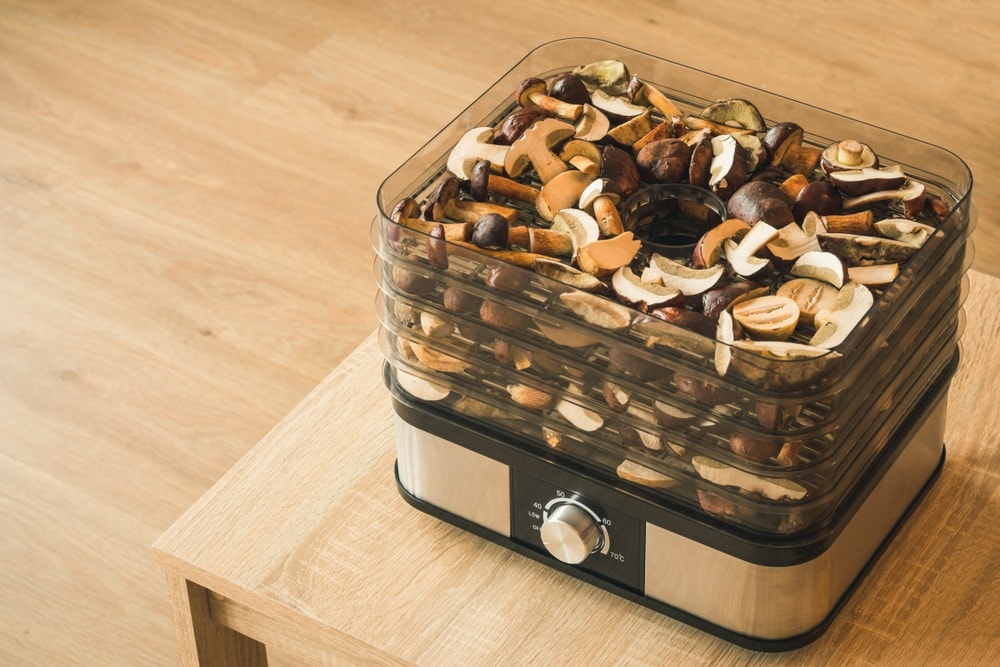
Drying mushrooms is the process of exposing the fungus to dry heated air. Not only does this preserve a lot of the original flavours of the mushroom but it also completely removes its water content.
The less water content, the less chance of microbes that cause organism decomposition. Bacteria thrive on slimy mushrooms, they really do love that stuff.
Drying mushrooms requires minimal effort and equipment. However, it can take longer than other preservation methods. This method requires a clean and odourless storage area that is available for days to even a week.
Drying will cause the most apparent physical changes to the original state of the mushrooms. Some species like Chanterelles don’t fair well with dehydration and often will lose flavor and texture.
Dried mushrooms will experience a lot of shrinkages, often up to 60 percent in size due to the water loss. However, the volume can be restored to a certain extent after rehydrating the mushroom.
Air drying wild mushrooms.
Air drying only requires a wire tray covered with baking paper or newspaper. Position the mushrooms evenly without overlapping. Store the tray in a well-aired sunlight room for at least 48 hours.
Mushrooms can absorb any surrounding smells, so make sure to air dry them away from aggressive smelling solvents and chemicals.
Drying cabinets a smell free solution.
A homemade drying rig can be a simple, more targeted solution to drying out wild mushrooms. If you have a spare cabinet with existing trays, you can use a low heat lamp to the base of the cabinet and leave overnight.
The benefit of having a cabinet is that it dramatically reduces contamination of external smells that may be absorbed into the mushrooms.
A dehydrator can dry fast and efficiently.
If you have the budget, buying an electric dehydrator is a fast and convenient method to dry out a considerable amount of mushrooms.
Dehydrators will reduce scent absorption due to its oven-like construction.
The best thing about dehydrators is that its easy to get consistent results. As long as your mushrooms have been prepared and portioned equally, all that’s left is to set the temperature and timer; the rest will take care of itself.
Some drying tips.
Time—Allocate a clean and well-ventilated area for your mushrooms to dry. The process can take anywhere from a few hours to days to complete so your space needs to allow time for it to take place.
Make it easier—Slice large mushrooms into slivers. Use smaller portions to allow for more effortless airflow and speed up the drying process.
Monitor—Check in on your mushrooms regularly. A way to tell when the mushrooms are fully dry is to try and snap one of the smaller mushrooms. A mushroom that isn’t fully dry may flex and bend, and a thoroughly dried mushrooms will become brittle and crisp.
Freezing—Freezing the mushrooms after drying can further eliminate bacteria. Use a freezer to store your wild mushrooms for up to a week. Once frozen you can then remove and place in a dry area of your choosing.
Re-hydrate—To reconstitute the fungi close to its original state, soak them in warm water for 15 to 30 minutes and then pat dry.
Canning, the truth.
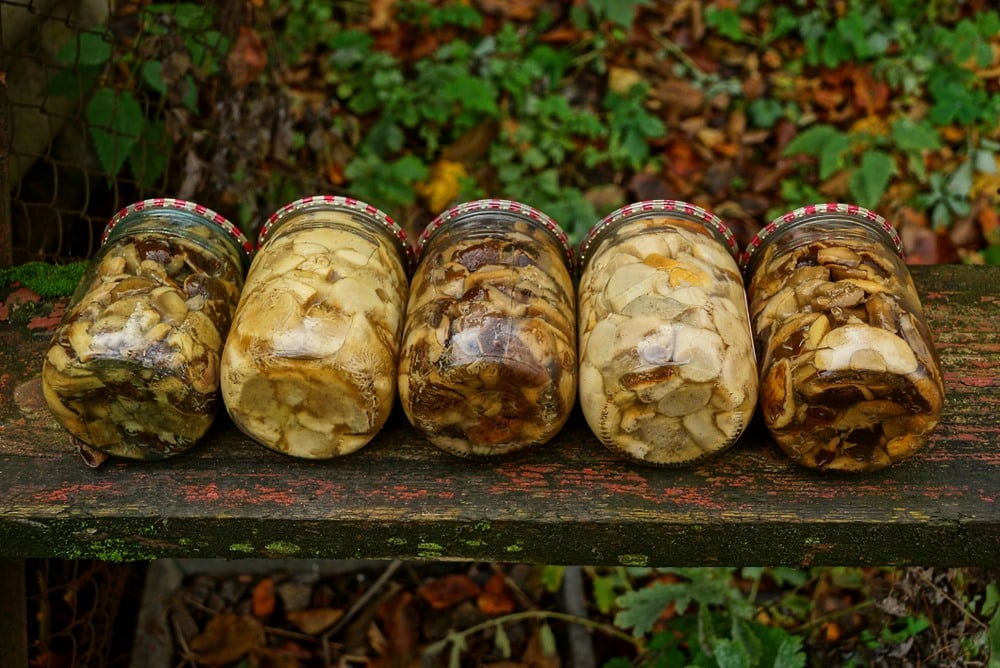
If you want your mushrooms to keep their most original state, then you may want to look at Canning. Canning allows for maximum water retention and traps in flavor. Unfortunately, it’s my least favored method of storing and preserving mushrooms.
Home Canning use is often a complicated high-risk procedure that requires sterile equipment and a high level of knowledge.
Unlike supermarket champignons, wild mushrooms not correctly identified can host toxins and bacteria.
If not done correctly, there is a real chance of inadvertently trapping unwanted bugs and toxins within the Can. The Center for Disease Control and Prevention (CDC) recorded 210 cases of Canned food poisoning or Botulism in 2018.
Shockingly, one hundred forty of these instances were due to improper home Canning methods, so there are real reasons to maybe give this method a hard pass. You have been warned.
So now that you know a few of the risks involved in Canning check out a brief overview below on how to Can and store mushrooms.
Canning – Is it worth it?
Mushrooms selections—The USDA highly recommends Canning button or champignons mushrooms. To minimize risk, make sure to never Can wild mushrooms.
Fortunately, button mushrooms are compact in size and shape compared to your wild mushrooms, which makes them a lot easier to clean and cook evenly and pack efficiently.
The prepping process—Trim off the fibrous stem of the mushrooms and wash thoroughly. The aim here is to remove discolouration. Slice more giant mushrooms down for size and fit.
Pre cooked mushrooms—Place the mushrooms into a pot of boiling water for approximately 5 minutes. Once satisfied with cooking mushrooms evenly, pour the mushrooms and boiling brine into the Jar or Can.
Make sure to leave a 3-centimeter headspace between the contents and the top of the Can.
Can and jar selection—If you are Canning with metals, check each Can meticulously for damage, rust swelling, and abnormalities. Discard Cans that fit this criterion immediately. Make sure to apply the same process of elimination to lids of the jar or Can.
Check carefully around the thread and check for rusting or gaps that may lead to leakages.
Storing wild mushrooms is a great skill to learn. I’ve often used harvested dried mushrooms for use in upcoming recipes and products. I have a few colleagues that collect wild plants and they swear by the drying method to archive rare and beautiful mushrooms.
By knowing how to store most mushrooms not only will save you time on trips, but it reduces over picking — making it much more sustainable practice for the environment.
Want to throw mushrooms on the BBQ? Click here to read our article on How Hot is a Campfire?

